BMW automobiles have long set themselves apart in the crowded luxury marketplace by being driver-oriented machines, offering a dynamic experience behind the wheel while maintaining a high degree of refinement. Products from BMW Motorrad are no different, bringing equal amounts of sportiness, capability and luxury to the table.
But just as BMW’s cars have adapted to changing times, so too have BMW’s motorcycles. Constant innovation, with a focus on safety and accessibility, have made their efforts to mint new riders among the most successful in the industry. Entry-level single-cylinder bikes and scooters seek to bring the joy of riding to urban mobility. Adventure and heritage motorcycles equipped with the brand’s signature boxer engine are instantly recognizable, thanks to the horizontally opposed cylinders—and even those Beemers that don’t bear such obvious marks can still be clearly identified, as all of them wear the iconic blue-and-white roundel on the gas tank.
BMW Motorrad History
BMW stands for “Bavarian Motor Works” (or Bayerische Motoren Werke, in German) and while the company is best-known for its cars, its motorcycle engine manufacturing predates their first automobile by nine years. BMW AG was founded in Munich in 1916 and produced airplane engines during World War I; in 1921, it began building motorcycle engines for other manufacturers before building their first bike, the R32, in 1923. (That R32 was the foundation of BMW motorcycles for decades; its shaft drive was in use until 1994.)
Following World War II, the company was given permission to start building motorcycles again in Western Germany in 1947; however, it had to start from scratch, as all its surviving blueprints and plans were at the facility in Eastern Germany under Soviet control. Following a trademark lawsuit in 1952, motorcycles produced at the Eisenach plant in East Germany wore a red-and-white roundel bearing the name EMW (Eisenacher Motoren Werke)to distance them from BMW. (If you think those bikes are highly sought-after collector’s items these days, you’d be correct.)
How BMW Names its Motorcycles
As is the case with its cars, BMW Motorrad uses an alphanumeric naming system for their motorcycles. The first part of the name is a letter, which corresponds to an engine type; currently, the BMW Motorrad lineup has six engine types that vary from scooters names start with a C (parallel twin-cylinder engines attached to a constantly variable clutch) to sport bikes like the $78,000 HP4 Race (high-performance four-stroke four-cylinder). Between those extremes, you have bikes starting with the letter S (four-cylinder sport motor), R (opposed twin-cylinder), G (single cylinder), F (parallel twin-cylinder), and K (three or more cylinders).
The second part of the name is comprised of numbers, which represent the size of the engine’s displacement in cubic centimeters….except when it’s actually just a random series of numbers instead, which does happen. Currently, models with the numbers 310, 400, 650, 750, 850, 1000, 1200, 1250, and 1600 fill up the lineup.
Lastly comes the letter or letters following the numbers—the part of the name that explains the purpose of the bike: A (for Adventure, sometimes spelled out), S (sometimes Sport or Strasse, the German word for street), G (from the German word Gelande, which means terrain), GT (sport touring), RR (road racing), RT (road touring), L (luxury), T (touring), GTL (luxury sport touring), B (bagger), R (road), X (extreme), and GSA (grand sport adventure, sometimes spelled out) all see use in 2019.
BMW Motorrad Terminology
BMW Motorrad: Pronounced “Moto-rad” (meaning “motorcycle” in German), this has been BMW AG’s motorcycle division since 1923.
Beemer/Beamer: Traditionally, “Bimmer” is the nickname for BMW cars, while “Beemer” or “Beamer” applies to the motorcycles. Why? Well, the etymology comes from the post-WWII era. BMW was competing with British bike company BSA, whose bikes were nicknamed “Beesers.” The “Beemer” nickname was attached to the BMW bikes in an effort to keep it from seeming like the staunch German brand.
Flat Twin: BMW’s iconic engine layout of choice, with two horizontally opposed cylinders mounted across the frame.
Airhead: The flat twin engine with two valves per cylinder produced from 1969 to 1995 that is cooled by air.
Oilhead: Partial oil cooling, which came to the flat twin boxer in 1995, when the cylinders gained two valves for a total of four.
Precision Cooling: A glycol/water coolant mixture is sent to the hottest part of the engine around the combustion chamber. This accounts for 35% of engine cooling; air and oil account for the other 65 percent. Precision water cooling arrived on the GS line of bikes in 2013.
GS: The literal translation of Gelände/Straße is “Off-road/Road,” but GS is also used interchangeably to mean Gelände Sport. The first BMW GS produced was the R80/GS in 1980 and continues through today; the line is easily identified by the long travel suspension and upright riding position, and bikes are often optioned with long distance touring accessories.
Shaft Drive: The final drive system of choice for BMW since the R32 arrived in 1923, consisting of a shaft that connects a gear inside the gearbox to another gear inside a hub on the rear wheel.
Urban Mobility (Scooters)
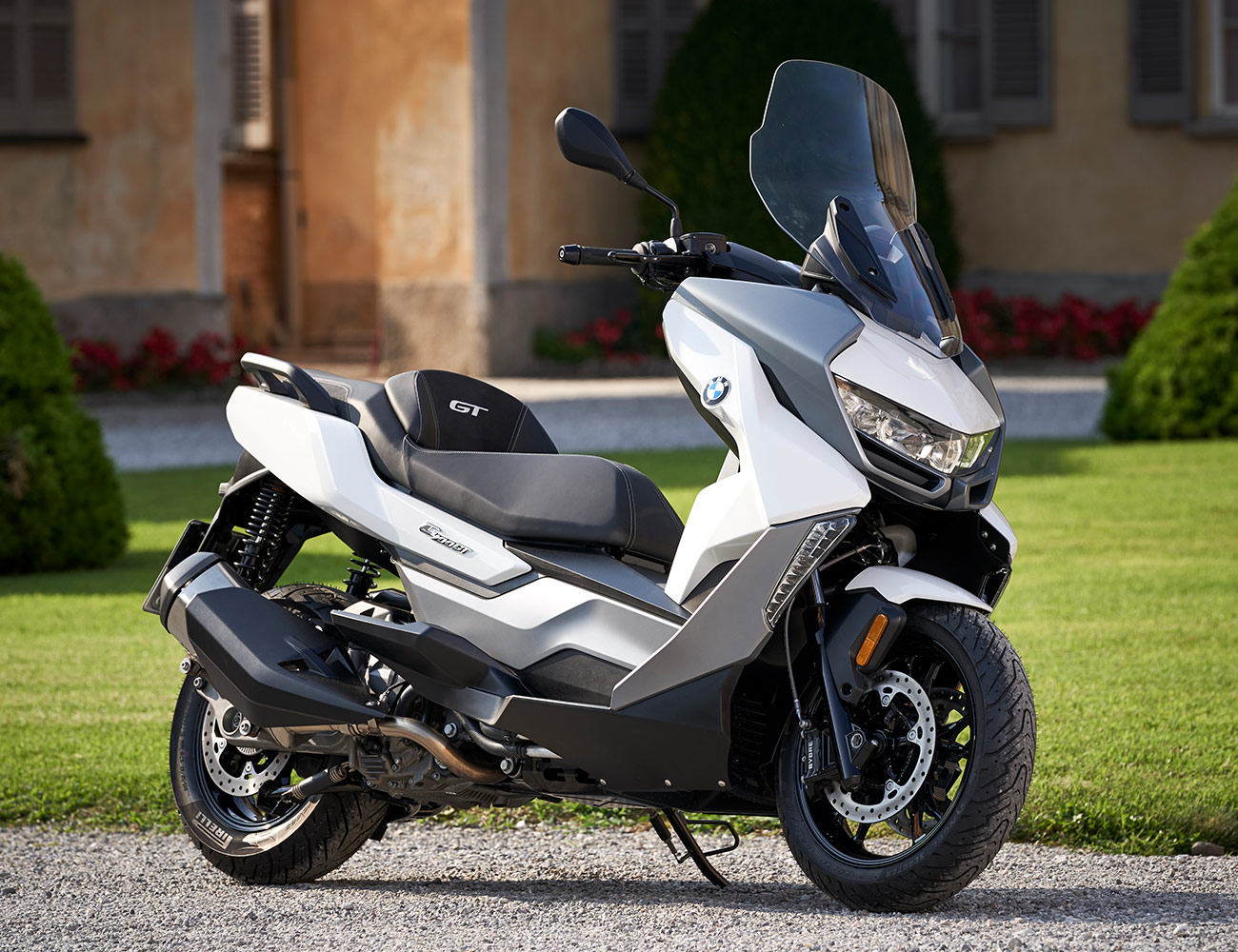
BMW Motorrad’s Urban Mobility segment consists of three scooters: two gas-powered models and a fully-electric model. The fuel burners are the C650 GT ($10,995) and C400 X ($6,795); the former is capable of covering long distances easily in addition to being a premium two-wheeled city street slayer, while the latter is a modern mid-size commuter with built-in smartphone connectivity. The single cylinder in the 400 X delivers 34 hp and 67 mpg, while the twin cylinder of the 650 GT offers 60 hp, 51 mpg, and a 112-mph maximum speed.
The fully electric C evolution ($13,995) has a powerful little electric motor with 48 hp and 53 lb-ft of torque, good for a 0-30 time of 2.8 seconds. It’s quick, futuristic looking and has a 99-mile range.
Models:
• C400X – $6,795
• C650GT – $10,995
• C evolution – $13,995
Engines:
• 350cc single
• 647cc inline twin
• 133v air-cooled lithium-ion high voltage battery
Adventure
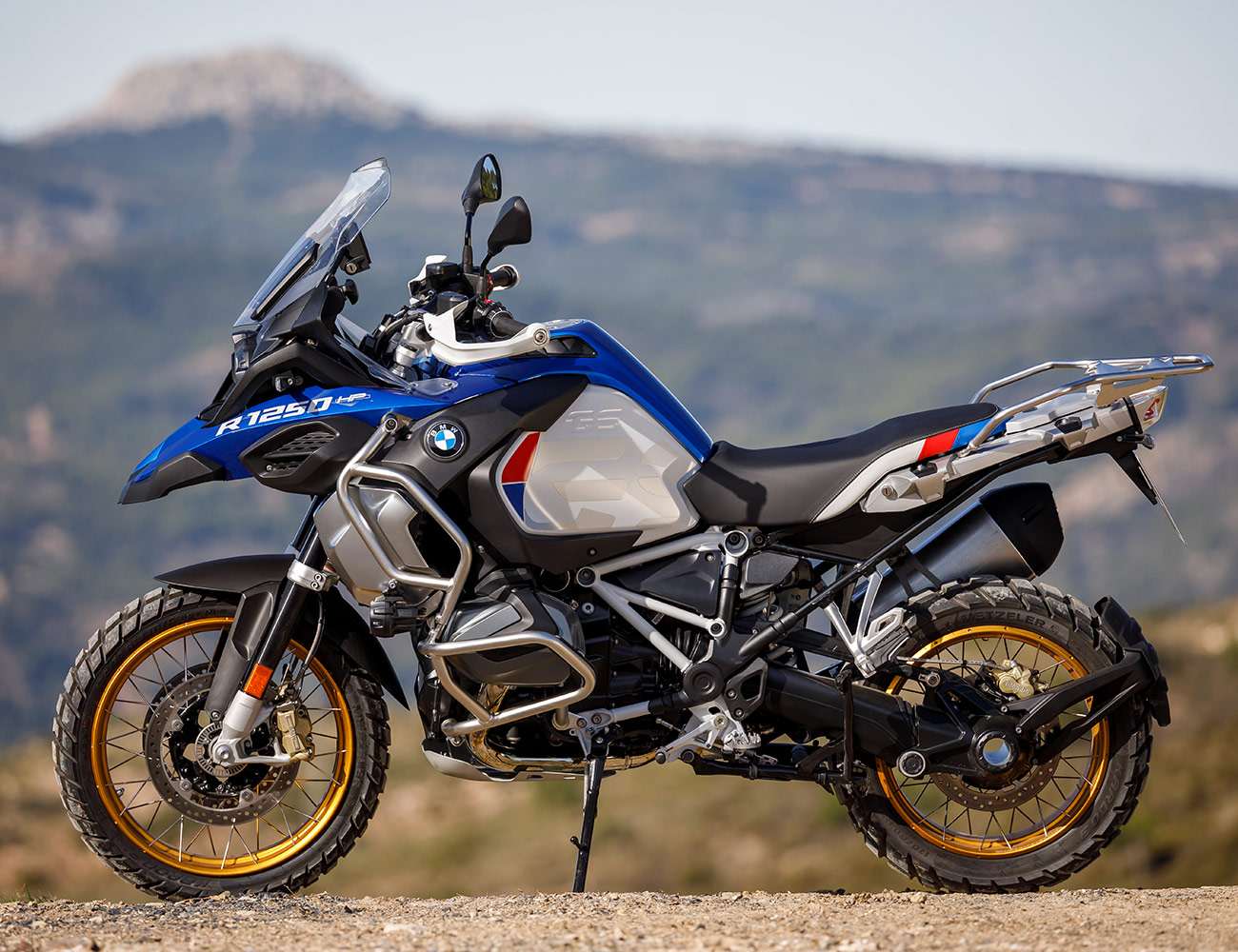
When BMW introduced the R80 G/S in 1980, it kicked off a whole new segment—one that has risen to new heights of popularity in the past few years, as smaller, more approachable adventure bikes have hit the market. So it stands to reason that the company that started it all would be producing the bikes to beat.(Car nerds, you can think of BMW’s “GS” motorcycles as the 3 Series of Motorrad.)
They range from the very accessible, fun-to-ride single cylinder G 310 GS ($5,795) up to the iconic R 1250 GS Adventure ($19,945), which can be found conquering continents with its 136-hp four-stroke flat twin. In between these two ends of the spectrum lie a number of great rides, including the F750 G S($10,395) with standard stability control and ABS, and the new F850 GS Adventure ($14,295) with a new 90-hp parallel twin cylinder engine and a smoother, more easily-operated clutch to reduce fatigue in tricky situations. Also noteworthy is the S 1000 XR ($16,895) which combines a 165-hp inline four-cylinder engine and sport bike riding dynamics with GS ergonomics and styling. There are countless ways to set up these bikes, but regardless of how you spec it, a GS is ready to eat up a ton of miles.
Models:
• G 310 GS – $5,795
• F 750 GS – $10,395
• F 850 GS – $13,195
• F 850 GS Adventure –$14,295
• S 1000 XR – $16,895
• R 1200 GS – $16,895
• R 1250 GS – $17,695
• R 1250 GS Adventure – $19,945
Engines:
• 313cc single
• 853cc parallel twin
• 853cc inline twin
• 999cc inline four
• 1,170cc stroke flat twin
Heritage
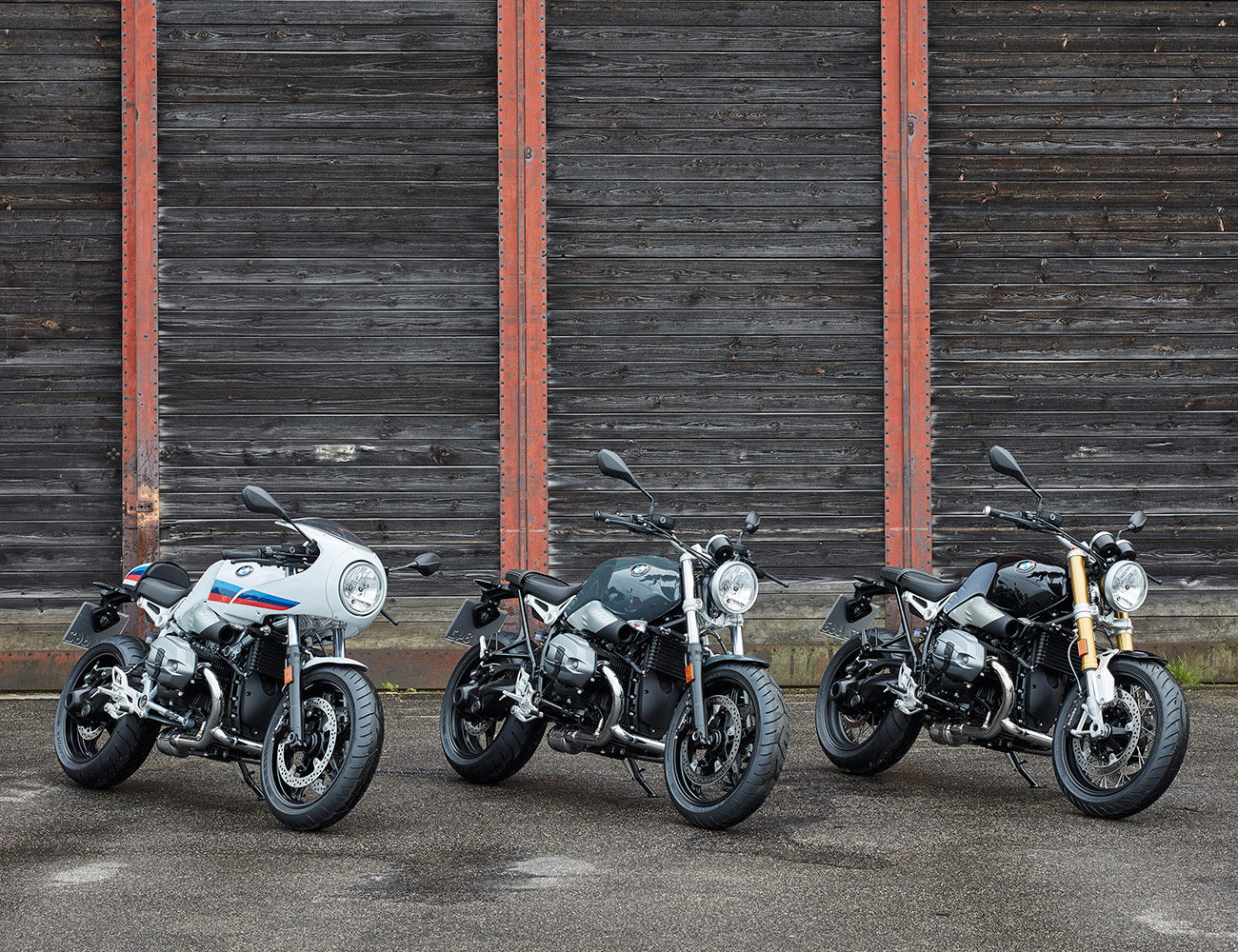
It was only a matter of time before stripped-down retro themed bikes had their moment. When BMW launched the R NineT in 2013, it was that moment. Here was an air-cooled boxer BMW with classic lines, but with optional heated grips and a factory warranty.
Since the launch, the R NineT family has expanded to five distinct models, ranging from the stripped-down, ready-for-customization R NineT Pure ($9,995) to the original R NineT ($15,495). There’s an R NineT Racer ($13,545), which boasts a sexy throwback front cowl and one of the most aggressive seating positions on the market. Then there’s the homage to the R80 G/S, the R NineT Urban G/S ($12,995); finally, there’s the R NineT Scrambler ($12,995) which brings knobby tires, a brown leather seat, and high-mounted dual exhaust. All five bikes use the same air/oil cooled twin cylinder boxer engine making 110 hp 86 lb-ft of torque. Oh and regardless of whether you go for the stock exhaust or optional Akropovic setup, they all sound phenomenal.
Models:
• R nineT Pure – $9,995
• R nineT Scrambler – $12,995
• R nineT Urban G/S – $12,995
• R nineT Racer – $12,545
• R nineT – $15,495
Engines:
• 1,170cc flat twin
Roadster
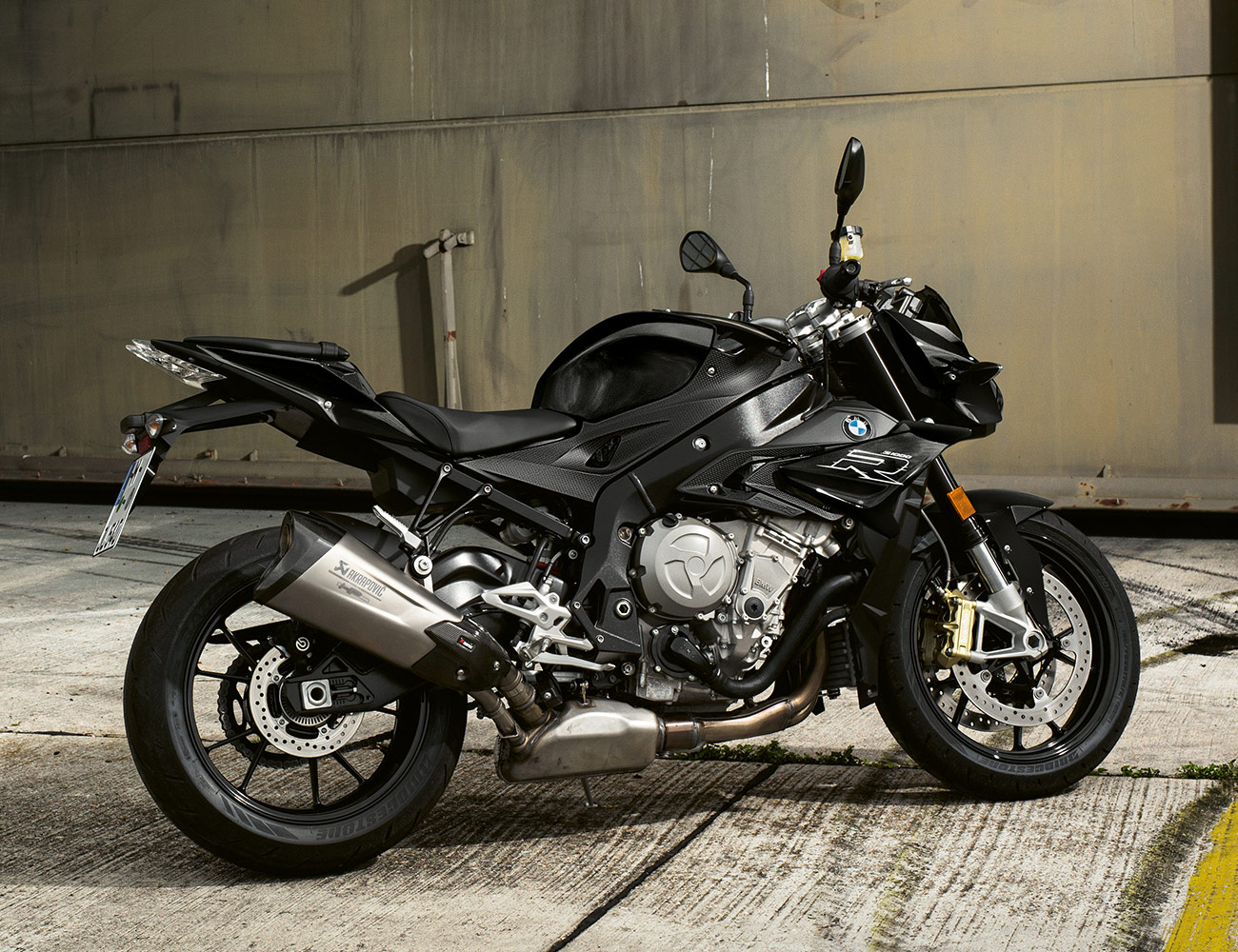
The Roadster segment is comprised of just two bikes, but the G 310 R ($4,750) and S 1000 R ($13,995) are hardly afterthoughts. The former represents an incredible value-for-money proposition, while the latter is a 165-hp beast with a standard titanium exhaust. The G 310 R is the more urban-oriented of the single-cylinder entry-level bikes, has already attracted a wide-ranging audience from new riders to custom builders. With a low center of gravity that’s been shifted towards the front wheel by rotating the cylinder head 180 degrees (thus giving the whole cylinder a rearward tilt) and a fully-fueled weight shy of 350 lbs, it offers an engaging riding experience that novices and veterans can both enjoy.
The S 1000 R, on the other hand, is just shy of being a full-blown sport bike. It’s an enthralling, stripped-down piece of machinery that somehow remains comfortable enough for commuting. It notably comes standard with Gear Shift Assist Pro, which lets you skip the hassle of engaging the clutch when ratcheting off shifts at full tilt.
Models:
• G 310 R – $4,750
• S 1000 R – $13,995
Engines:
• 313cc single-cylinder
• 999cc inline-four
Touring
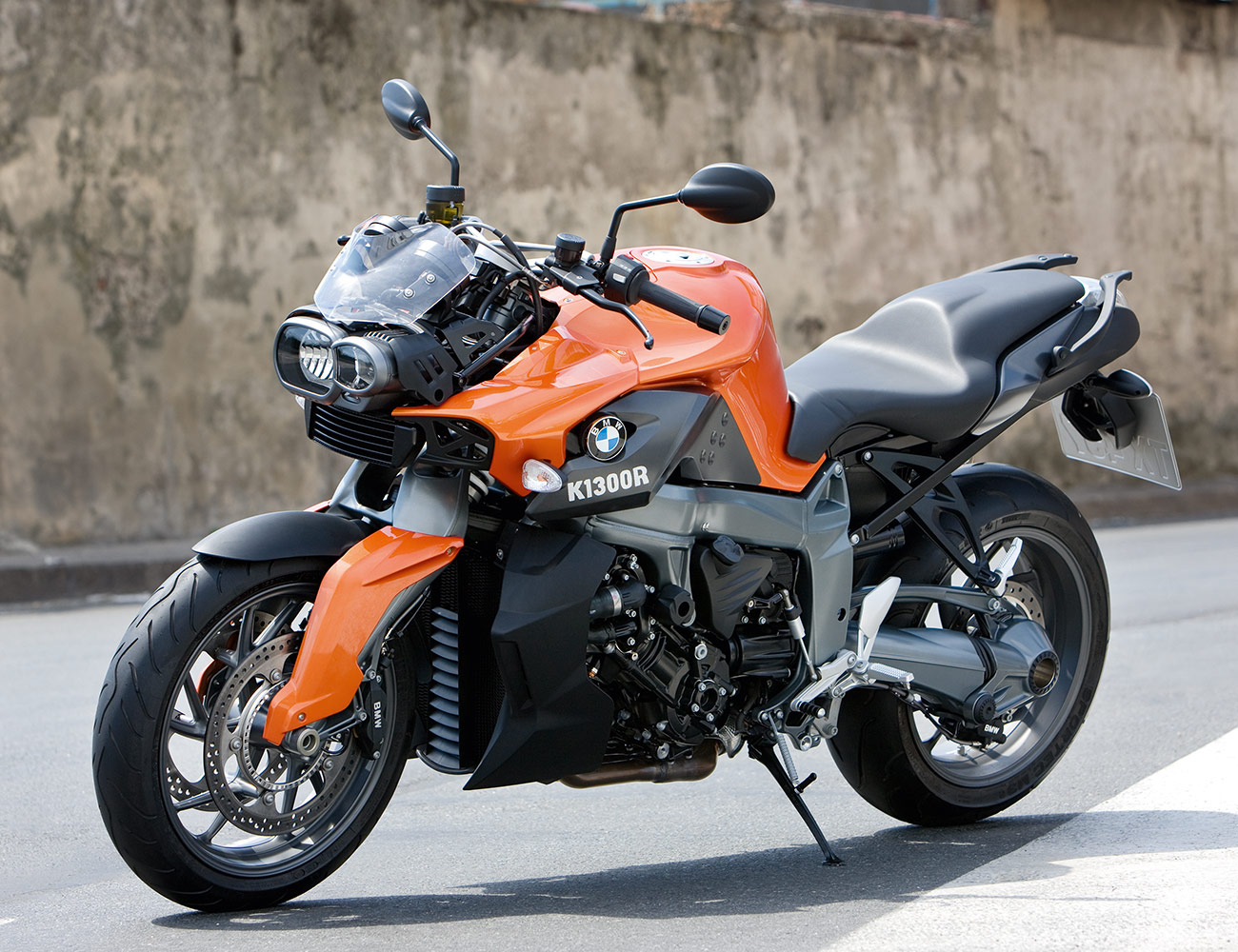
This is the other big segment for BMW, next to their Adventure bikes. BMW touring bikes can be found covering large swaths of land around the globe—and if you swing through notable riding zones like the Tail Of The Dragon, you’re guaranteed to spot a few well-to-do folks cruising in comfort on them. It’s kind of outrageous that the K 1600 B ($20,095) even exists; after all, when you think of BMW motorcycles, you don’t think of baggers. But there it is: six cylinders all in a row, a low-slung silhouette, taillights you can’t ignore, and an incredible amount of road presence.
The R 1250 RT ($18,645) boasts a new twin-cylinder boxer making 136 hp and 105 lb-ft, and makes use of a new variable camshaft control system dubbed “BMW ShiftCam” that gives access to more torque across the powerband by using variable valve timing. On a big bike like this, that’s exactly what riders are looking for: ease of riding, comfort, and doing the long rides in style. None do it better than especially the K 1600 GTL ($25,995) which has dual adaptive xenon headlights and an electrically-adjustable windscreen. (Yes, you read that right.) Other than the HP4 Race, it’s BMW’s most expensive motorcycle—but read the build sheet and you’ll understand why.
Models:
• K 1600 B – $20,095
• K 1600 Grand America – $25,595
• K 1600 GTL – $25,995
• K 1600 GT – $22,995
• R 1250 RT – $18,645
• R 1200 RT- $18,395
Engines:
• 1,170cc boxer twin
• 1,649cc inlin- six
Sport
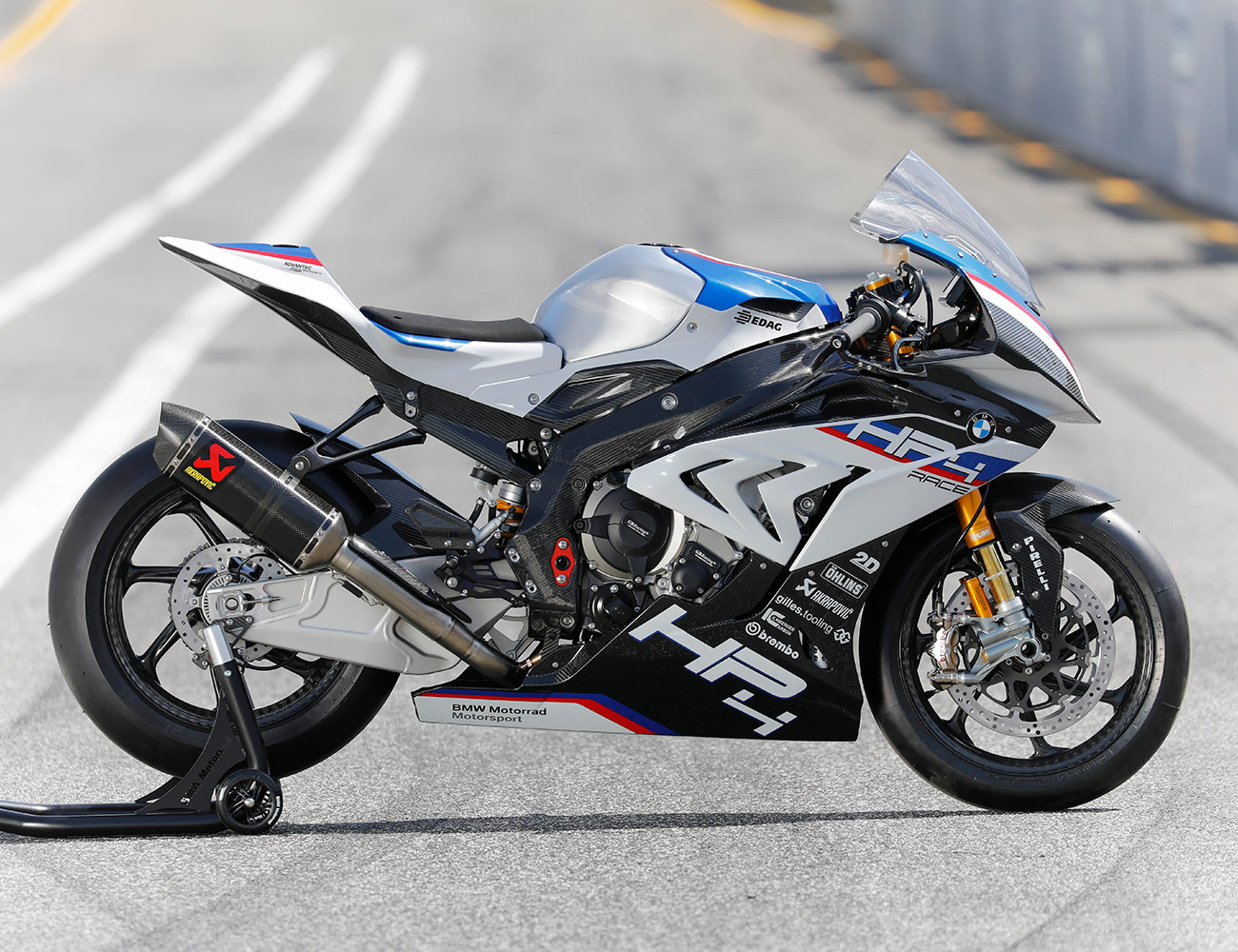
For a brand that’s had so much success in racing and is generally associated with “sportiness” by consumers, oddly enough, sport bikes aren’t the first thing that comes to mind when most people think of BMW Motorrad. Perhaps it’s because the Adventure and Touring bikes dominate in their respective categories and all those Italian sport bikes just scream “FAST”—but make no mistake, BMW builds seriously capable sport bikes.
A new S 1000 RR ($16,995) is on the way; the release date is still unconfirmed, but when it arrives, it’s going to shake things up in the sportbike scene faster, lighter, and nuttier than the current S 1000 RR ($15,995). The inline four-cylinder engine is now making 205 hp at 13,000 rpm, and redline doesn’t arrive until 14,600 rpm. With the optional M Package selected, weight is reduced by an extra 7.7 lbs to bring the bike down to 427 lbs.
Should you want to take your track day to the ultimate level, there’s the HP4 Race ($78,000) with carbon-fiber frame and wheels. Here the inline four-cylinder makes 215 hp, while the curb weight rings up at 322 lbs. It’s their ultimate handmade two-wheeler, and BMW’s building just 750 of them, so plan accordingly—and act fast.
Models:
• HP4 Race – $78,000
• S 1000 RR – $16,995
Engines:
• 999cc Inline Four

